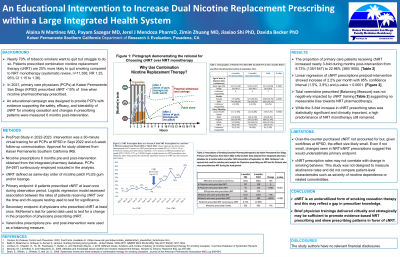(31) Increasing Dual Nicotine Replacement Prescribing within a Large Integrated Health System
Friday, April 5, 2024
9:45 AM - 1:15 PM


Payam Sazegar, MD, FASAM
Assistant Professor
Kaiser Permanente Bernard J. Tyson School of Medicine, California
Alaina Martinez, MD
Addiction Medicine Fellow
University of Arizona, Arizona- JM
- JS
- ZZ
- DB
Presenter(s)
Non-presenting author(s)
Background & Introduction: Most tobacco smokers want to quit but fail to succeed. Combination NRT (cNRT), use of controller plus reliever, is the most effective way to prescribe nicotine but is infrequently prescribed. We examined the feasibility and efficacy of a simple educational intervention in a large integrated health system to influence NRT prescribing behavior of primary care physicians (PCPs) to increase cNRT prescribing.
Methods: A prospective cohort study performed 2022-2023 at a large integrated health system in California where specific NRT products are covered with a prescription. A primary care department was offered a 30-minute virtual training about cNRT during a required monthly department meeting. Training consisted of an interactive format, 3 simple asks and a 6-week follow-up communication. The physician (intervention) group served as its own control, comparing cNRT prescriptions by PCPs collected from the integrated pharmacy database from 6 months pre- and post-intervention. Only adult patients (age 18 and over) and PCPs continuously employed during the study period (n=267) were included in the analysis. Primary endpoint was the number of patients prescribed cNRT at least once during the observation period. Secondary endpoint was number of physicians prescribing cNRT at least once. As a balancing measure, we looked at varenicline prescriptions pre- and post-intervention. Chi-square analysis was used to test for differences in cNRT prescribing patterns in the 6 months pre- and post-intervention using Stata software.
Results: 180 of 202 (89%) of participants completed the post-training questionnaire. Respondents reported improved confidence, attitudes, and intention to change prescribing behavior. Six months post-training there was no significant difference in number of physicians who prescribed NRT; however, physicians prescribing cNRT increased 59% (pre 78; post 124; p< 0.001) accounting for a 281% increase in the total number of patients receiving cNRT (pre 135; post 380; p< 0.001) compared to 6 months pre-training. Varenicline prescriptions did not decrease as a result of the intervention.
Conclusion & Discussion: cNRT is often underutilized as a form of smoking cessation therapy and may reflect a gap in prescriber knowledge. Brief guideline-based educational interventions for PCPs, when delivered virtually and implemented strategically, may be sufficient to skew cNRT prescribing patterns in favor of cNRT among patients desiring nicotine products for smoking cessation. Implementation of an electronic clinical decision support tool to support practice change was undertaken and future research is needed to measure its long-term impact on prescription patterns, abstinence rates and other patient outcomes.
References: 1. Centers for Disease Control and Prevention. Smoking Cessation: Fast Facts. Centers for Disease Control and Prevention. Published May 21, 2020. Last reviewed March 21, 2022. https://www.cdc.gov/tobacco/data_statistics/fact_sheets/cessation/smoking-cessation-fast-facts/index.html.
2. Babb S, Malarcher A, Schauer G, Asman K, Jamal A. Quitting Smoking Among Adults — United States, 2000–2015. MMWR Morbidity and Mortality Weekly Report. 2017;65(52):1457-1464. doi:https://doi.org/10.15585/mmwr.mm6552a1.
3. Jamal, Dube, SR, Malarcher, AM, Shaw, L, Engstrom, MC, & Centers for Disease Control Prevention. (2012). Tobacco use screening and counseling during physician office visits among adults--National Ambulatory Medical Care Survey and National Health Interview Survey, United States, 2005-2009. MMWR. Morbidity and Mortality Weekly Report, 61, 38–45.
4. Geletko KW, Graves K, Lateef H, Harman J. Tobacco Cessation Counseling and Medications Provided by Physicians to Tobacco Users During Primary Care Visits. Journal of Primary Care & Community Health. 2022;13:215013192210931. doi:https://doi.org/10.1177/21501319221093115.
5. Barnett PG, Ignacio RV, Kim HM, et al. Cost‐effectiveness of real‐world administration of tobacco pharmacotherapy in the United States Veterans Health Administration. Addiction. 2019;114(8):1436-1445. doi:https://doi.org/10.1111/add.14621.
Methods: A prospective cohort study performed 2022-2023 at a large integrated health system in California where specific NRT products are covered with a prescription. A primary care department was offered a 30-minute virtual training about cNRT during a required monthly department meeting. Training consisted of an interactive format, 3 simple asks and a 6-week follow-up communication. The physician (intervention) group served as its own control, comparing cNRT prescriptions by PCPs collected from the integrated pharmacy database from 6 months pre- and post-intervention. Only adult patients (age 18 and over) and PCPs continuously employed during the study period (n=267) were included in the analysis. Primary endpoint was the number of patients prescribed cNRT at least once during the observation period. Secondary endpoint was number of physicians prescribing cNRT at least once. As a balancing measure, we looked at varenicline prescriptions pre- and post-intervention. Chi-square analysis was used to test for differences in cNRT prescribing patterns in the 6 months pre- and post-intervention using Stata software.
Results: 180 of 202 (89%) of participants completed the post-training questionnaire. Respondents reported improved confidence, attitudes, and intention to change prescribing behavior. Six months post-training there was no significant difference in number of physicians who prescribed NRT; however, physicians prescribing cNRT increased 59% (pre 78; post 124; p< 0.001) accounting for a 281% increase in the total number of patients receiving cNRT (pre 135; post 380; p< 0.001) compared to 6 months pre-training. Varenicline prescriptions did not decrease as a result of the intervention.
Conclusion & Discussion: cNRT is often underutilized as a form of smoking cessation therapy and may reflect a gap in prescriber knowledge. Brief guideline-based educational interventions for PCPs, when delivered virtually and implemented strategically, may be sufficient to skew cNRT prescribing patterns in favor of cNRT among patients desiring nicotine products for smoking cessation. Implementation of an electronic clinical decision support tool to support practice change was undertaken and future research is needed to measure its long-term impact on prescription patterns, abstinence rates and other patient outcomes.
References: 1. Centers for Disease Control and Prevention. Smoking Cessation: Fast Facts. Centers for Disease Control and Prevention. Published May 21, 2020. Last reviewed March 21, 2022. https://www.cdc.gov/tobacco/data_statistics/fact_sheets/cessation/smoking-cessation-fast-facts/index.html.
2. Babb S, Malarcher A, Schauer G, Asman K, Jamal A. Quitting Smoking Among Adults — United States, 2000–2015. MMWR Morbidity and Mortality Weekly Report. 2017;65(52):1457-1464. doi:https://doi.org/10.15585/mmwr.mm6552a1.
3. Jamal, Dube, SR, Malarcher, AM, Shaw, L, Engstrom, MC, & Centers for Disease Control Prevention. (2012). Tobacco use screening and counseling during physician office visits among adults--National Ambulatory Medical Care Survey and National Health Interview Survey, United States, 2005-2009. MMWR. Morbidity and Mortality Weekly Report, 61, 38–45.
4. Geletko KW, Graves K, Lateef H, Harman J. Tobacco Cessation Counseling and Medications Provided by Physicians to Tobacco Users During Primary Care Visits. Journal of Primary Care & Community Health. 2022;13:215013192210931. doi:https://doi.org/10.1177/21501319221093115.
5. Barnett PG, Ignacio RV, Kim HM, et al. Cost‐effectiveness of real‐world administration of tobacco pharmacotherapy in the United States Veterans Health Administration. Addiction. 2019;114(8):1436-1445. doi:https://doi.org/10.1111/add.14621.
Learning Objectives:
- Acquire knowledge about the safety, efficacy and tolerability of Combination Nicotine Replacement Therapy for smoking cessation.
- Learn how to design a performance improvement project to increase tobacco cessation pharmacotherapy prescribing by primary care physicians.
- Acquire skills in educating patients and front-line clinicians about benefits and pitfalls of commonly used pharmacotherapies for smoking cessation.
